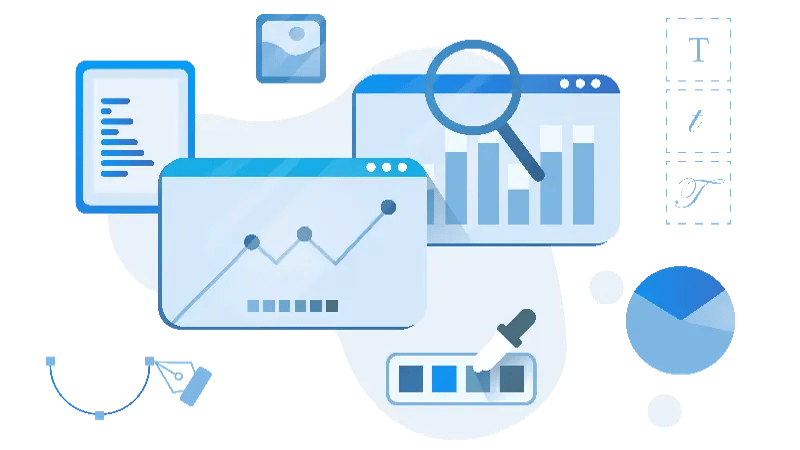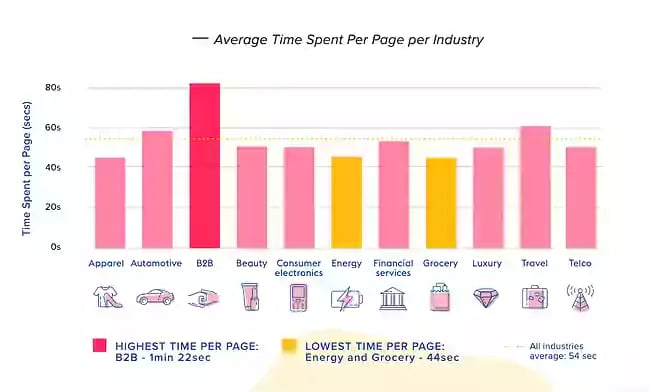Refonte d'un site web axée sur la croissance : 6 indicateurs à suivre
Après une refonte de site web axée sur la croissance, vous ne pouvez plus vous contenter de "l'installer et de l'oublier" !
Au "bon vieux temps", les sites web étaient relativement statiques. Une entreprise pouvait consacrer plusieurs mois, voire un an ou plus, à la refonte d'un site web, obtenir un résultat parfait (ou ce qui semblait l'être) et le laisser en l'état pendant plusieurs années jusqu'à ce qu'il soit temps de lui donner un nouveau look. Aujourd'hui, la stratégie de refonte d'un site web est quelque peu différente.

Hélas, votre site web n'est PAS un poulet rôti. Cette approche ne suffit plus pour de multiples raisons :
-
Les sites web sont devenus plus que des brochures en ligne : Pendant de nombreuses années, les sites web ont principalement existé en tant que brochures en ligne. Les gens pouvaient visiter votre site, lire des informations sur votre entreprise et prendre le téléphone pour vous appeler. Aujourd'hui, nos sites web peuvent être des outils de génération de prospects complexes et robustes qui soutiennent et renforcent les efforts de votre équipe de vente.
-
Les attentes des consommateurs ont changé : Tout comme le rôle des sites web, les attentes des clients ont évolué. Il y a quinze ans, les gens n'auraient pas imaginé que la plupart de leurs opérations bancaires pouvaient (et allaient) être effectuées en ligne sans avoir à se rendre dans une banque. Aujourd'hui, environ 80 % des gens préfèrent effectuer leurs opérations bancaires exclusivement en ligne. Quelle en est la conséquence ? Le site web de votre entreprise doit faciliter le libre-service autant que possible et offrir une expérience utilisateur exceptionnelle.
-
Votre entreprise et votre secteur d'activité sont en constante évolution : Qu'il s'agisse de l'évolution des conditions du marché, de technologies perturbatrices ou de concurrents émergents, votre entreprise doit constamment s'adapter pour tenir compte de nouveaux facteurs. Votre site web doit également évoluer pour refléter votre réponse à ces défis.
C'est la raison pour laquelle nous avons constaté (et recommandons toujours) le passage d'un développement de site web traditionnel à une méthodologie de conception axée sur la croissance (GDD). Cette approche garantit que votre site web fonctionne comme un "membre virtuel" de votre équipe de marketing et de vente, en générant des leads, en facilitant les conversions et en aidant votre entreprise à atteindre ses objectifs de croissance.
Indicateurs de performance à suivre après la refonte de votre site web axée sur la croissance
Avec la méthodologie de conception axée sur la croissance, le véritable travail commence après le lancement. C'est à ce moment-là que vous devez être très attentif aux performances de votre site web. Ces données doivent guider toutes les décisions ultérieures de refonte du site web, qu'il s'agisse des nouvelles pages que vous ajoutez, de l'emplacement des CTA ou même des champs que vous incluez dans les différents formulaires du site web.
Vous ne savez pas par où commencer ni quels indicateurs suivre ? Ces six indicateurs vous fourniront la plupart des données dont vous avez besoin pour prendre des décisions de conception axées sur la croissance.
1. Trafic global du site
Nous avons tendance à considérer la conception d'un site web comme une question d'esthétique, même dans le contexte d'une augmentation des conversions. Par exemple, nous pourrions envisager de modifier la position ou la couleur d'un bouton pour obtenir plus de clics.
Le référencement devrait figurer en bonne place dans votre stratégie de conception axée sur la croissance. Au minimum, chaque nouvelle page web que vous créez doit être construite autour d'un mot-clé spécifique ayant un volume de recherche suffisant et correspondant à vos profils d'acheteurs.
Si vous avez pris en compte le référencement dans votre stratégie de conception axée sur la croissance, vous devriez constater une augmentation du trafic organique au fil du temps. Pas d'augmentation du trafic ? Il est peut-être temps de reconsidérer la question
2. Taux de rebond du site
Le taux de rebond mesure essentiellement la durée pendant laquelle les visiteurs restent sur votre site web. Un taux de rebond élevé se traduit par une visite plus courte, tandis qu'un taux de rebond faible signifie que les gens ont tendance à rester, ce qui indique un plus grand engagement. Parfois, un taux de rebond élevé est prévisible (par exemple, sur votre page d'accueil). Mais dans la plupart des cas, un taux de rebond faible est préférable.
Qu'est-ce qu'un "bon" taux de rebond ? Cela dépend. Mais selon SEMRush, le taux de rebond moyen est de 44 à 50 %, et un bon taux de rebond serait de 26 à 40 %.
De nombreux facteurs peuvent contribuer à un taux de rebond élevé :
-
Temps de chargement des pages trop lent : personne ne veut attendre le chargement de votre site Web, surtout s'il est consulté à partir d'un appareil mobile. Le chargement des pages ne devrait pas prendre plus de trois secondes, même si c'est long selon les normes d'aujourd'hui.
-
Navigation difficile sur le site : la navigation sur votre site web, y compris la recherche sur le site, doit être facile et intuitive. Si les visiteurs ne trouvent pas facilement ce qu'ils cherchent, ils passeront rapidement à autre chose. Les sites plus complexes peuvent nécessiter des indices de navigation supplémentaires (tels que des fils d'Ariane) pour aider les visiteurs à se déplacer plus facilement.
-
Contenu peu engageant : le contenu n'est peut-être pas celui auquel le visiteur s'attendait, ou bien il n'est tout simplement pas assez intéressant ou informatif. Si les internautes sont déçus par la qualité de votre contenu, ils chercheront souvent une autre source.
-
Longs blocs de texte : Soyons réalistes : la plupart des lecteurs en ligne ne cherchent qu'à survoler le contenu. Des études montrent que même des personnes possédant des diplômes de haut niveau préfèrent consommer des contenus en ligne rédigés à un niveau de lecture allant de la sixième à la neuvième année (même s'il s'agit d'un sujet relevant de leur domaine d'activité). Les longs blocs de texte peuvent être intimidants et il est alors très difficile de trouver l'information recherchée.
-
Absence d'appels à l'action: les appels à l'action aident vos visiteurs à passer à l'étape logique suivante en s'engageant sur votre site web. Ils risquent de quitter le site s'ils arrivent à la fin d'une page web et ne savent pas quoi faire à partir de là.
Notez que bon nombre de ces éléments résultent directement de la conception de votre site web. Au fur et à mesure de l'évolution de votre site web, réfléchissez aux possibilités d'améliorer votre taux de rebond sur chaque page.
3. Temps passé sur le site
Le temps passé sur le site est étroitement lié au taux de rebond. De courtes visites indiquent un manque d'engagement, tandis que des visites plus longues indiquent que les utilisateurs ont trouvé quelque chose qui les intéresse.
Si votre stratégie de contenu est essentielle pour améliorer le temps passé par les visiteurs sur le site, la conception de votre site web peut également y contribuer (en particulier les éléments qui ont un impact sur le taux de rebond).
À titre de référence, le temps moyen passé sur le site, tous secteurs confondus, est de 54 secondes. Cependant, Contentsquare a analysé des données provenant de divers secteurs et a constaté que ce chiffre varie considérablement d'un secteur à l'autre. En particulier, le temps moyen est beaucoup plus élevé pour les entreprises B2B que pour les entreprises B2C.
La leçon à retenir : utilisez les performances actuelles de votre site web comme premier et plus important point de référence, et construisez à partir de là.
4. Taux de conversion
Les taux de conversion sont sans doute l'indicateur le plus important d'une conception axée sur la croissance. Après tout, ce sont les conversions qui permettent à votre entreprise de se développer !
Conversions CTA
Nous devons décomposer cet aspect en deux mesures distinctes :
-
-
Vues des CTA : combien de personnes voient vos CTA en premier lieu ? Ils ne peuvent pas cliquer sur ce qu'ils ne voient pas. Pour améliorer le nombre de consultations des CTA, vous pouvez modifier l'emplacement de vos boutons CTA (par exemple, en les plaçant "au-dessus du pli") ou ajouter d'autres CTA. Par exemple, vous pouvez envisager d'ajouter un CTA dans les premiers paragraphes de vos articles de blog afin que les internautes n'aient pas à défiler jusqu'au bas de l'article pour trouver leur première opportunité de conversion.
-
Taux de conversion des CTA : Quel est le pourcentage de clics sur les CTA ? Ce point est essentiel, car il représente une véritable opportunité de conversion. Si vos CTA sont beaucoup vus mais peu cliqués, il est temps de reconsidérer votre appel à l'action. Parfois, une refonte peut s'avérer utile ; si votre CTA n'est pas assez visible, les internautes risquent de passer à côté. Dans d'autres cas, vous devrez réfléchir plus en profondeur pour déterminer si votre offre correspond aux objectifs et aux besoins des visiteurs de votre site web, ce qui revient à comprendre vos buyer personas.
-
Conversions sur la page d'atterrissage
Les conversions de la page d'atterrissage sont le pain et le beurre de votre site web, car c'est ce qui (devrait) générer une proportion importante de vos nouveaux contacts et prospects. Selon HubSpot, le taux de conversion moyen des pages d'atterrissage, tous secteurs confondus, est de 9,7 %.
Cela vous semble-t-il un objectif ambitieux ? Les données de HubSpot fournissent également des indications sur la manière dont vous pouvez vous améliorer :
La longueur du formulaire : Les formulaires ayant le taux de conversion le plus élevé ne comportent que trois champs. (Une mise en garde s'impose ici : cela peut également produire un volume plus élevé de prospects moins qualifiés).
Contenu : Répondre aux craintes ou aux réserves de l'acheteur peut augmenter le taux de conversion de 80 %. Par ailleurs, 30 % des pages d'atterrissage les plus performantes utilisent des vidéos, 36 % des témoignages et 11 % des avis.
Personnalisation : les CTA personnalisés convertissent 202 % de plus que les CTA par défaut.
Pourcentage de MQL et de SQL
Nous connaissons tous la vieille expression "Garbage in, garbage out". Il en va de même pour les contacts générés par votre site web. S'il s'agit de déchets, votre équipe de vente deviendra grincheuse. Contrairement à Oscar, ils n'aiment pas les déchets !
Si vous disposez d'une vaste base de données de contacts mais de très peu de MQL et de SQL, il est temps de réfléchir au chemin de conversion que vous offrez aux visiteurs. Quelques questions à se poser :
Notre site web propose-t-il du contenu pour chaque étape du parcours de l'acheteur ? Il est relativement courant d'avoir beaucoup de pages et d'offres pour les visiteurs qui se trouvent dans les phases de sensibilisation et de considération, mais d'être pauvre en contenu pour la phase de décision.
Invitons-nous activement les gens à s'inscrire à une communication continue ? Un bon exemple est un formulaire pop-up qui invite les gens à s'abonner à votre blog. Cette tactique semble simple, mais elle peut avoir des résultats incroyables car elle permet aux internautes de continuer à interagir avec votre contenu et de passer potentiellement à la phase suivante du parcours de l'acheteur.
Notre contenu correspond-il vraiment aux besoins de nos buyer personas ? Si vous continuez à enregistrer des taux de conversion médiocres malgré d'autres changements, il est peut-être temps de revoir vos buyer personas. Votre site web manque peut-être de clarté dans son message. Vous vous sentez bloqué ? Une approche consiste à demander à un client de confiance de revoir votre site web. Que cherche-t-il ? L'ont-ils trouvé ? Quelles autres informations seraient utiles ?
6. Nombre d'affaires conclues
La conclusion d'affaires est sans aucun doute le travail de votre équipe de vente, n'est-ce pas ? Bien sûr, mais votre site web doit faire sa part du travail. En fin de compte, l'objectif principal de votre site web est de soutenir et d'améliorer les efforts de votre équipe de vente.
Une refonte de site Web axée sur la croissance comprend des éléments qui aideront votre équipe de vente à conclure l'affaire... avant même qu'elle n'entre en contact avec un prospect. Par exemple, le contenu de votre site web devrait inclure les éléments suivants :
-
des réponses aux réserves, aux objections ou aux craintes des clients potentiels concernant leur engagement avec votre entreprise
-
Des preuves sociales que le prospect fait le bon choix (par exemple, des études de cas, des comparaisons avec la concurrence, etc.)
-
Une distillation claire du problème commercial que votre produit ou service résout et de la manière dont cette solution peut fonctionner pour vos clients potentiels.
Gardez ces paramètres au centre de votre stratégie lorsque vous procédez à la refonte de votre site web axée sur la croissance. Ils vous fourniront les données dont vous avez besoin pour prendre des décisions plus éclairées et atteindre les objectifs de croissance de votre entreprise.
Vous voulez savoir où en est votre site web actuel ? Notre outil gratuit d'évaluation de sites web en ligne vous fournira de nombreuses informations précieuses.
Ce contenu est disponible en:
- Allemand: Wachstumsorientiertes Design Ihrer Website: 6 wichtige Metriken
- Anglais: Growth-Driven Website Redesign: 6 Metrics to Track
- Espagnol: Rediseño web orientado al crecimiento: 6 métricas clave
- Italien: Redesign del sito web growth-driven: 6 metriche da tracciare
- Roumain: Redesign site web bazat pe creștere: 6 metrici de urmărit
- Chinois: 以增长为导向的网站重新设计:需要跟踪的 6 个指标








Commentez ci-dessous